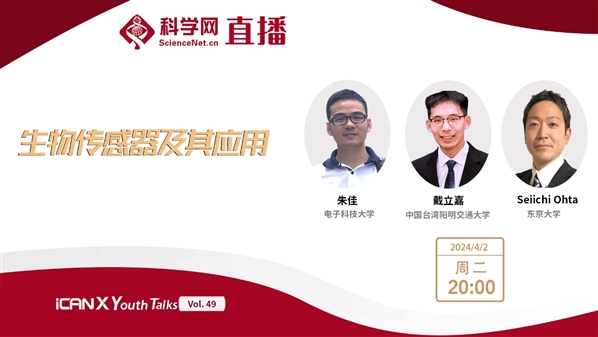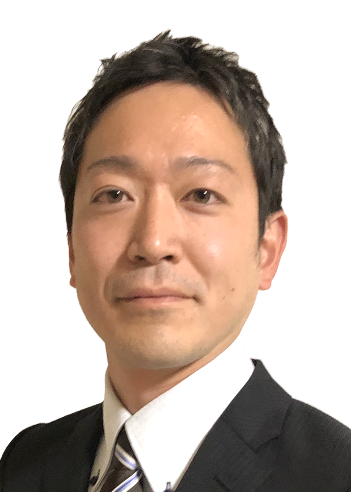
直播时间:2024年4月2日(周二)20:00-22:00
直播平台:

科学网APP
https://weibo.com/l/wblive/p/show/1022:2321325018716642607374
(科学网微博直播间链接)

科学网微博

科学网视频号
北京时间4月2日晚八点,iCANX Youth Talks第四十九期邀请到了电子科技大学Jia Zhu,中国台湾阳明交通大学Li-Chia Jerry Tai,东京大学Seiichi ohta三位教授主讲,香港科技大学Hnin YY Nyein作为主持人,香港科技大学I-Ming Hsing教授,新加坡国立大学Saif A. Khan教授担任嘉宾,期待你一起加入这场知识盛宴。
【嘉宾介绍】

Jia Zhu
电子科技大学
Novel Flexible Electrochemical Sensors for Visualized Clinical Care
【Abstract】
Real-time,non-invasive, and continuous monitoring of physiological parameters has great clinical implications in both health management and disease treatment. A plausible way towards this goal is to leverage the state-of-the-art flexible electronics technology that combines excellent mechanical pliability and electronic functionalities. Despite tremendous advances in flexible electronics technology, non-invasive and continuous monitoring of the trace amount of biomarkers in various biofluids remains a formidable challenge. In this talk, I will introduce strategies for designing sensitive flexible electrochemical sensors for real-time biomarker detection, including leveraging highly reactive porous materials or metal oxide thin films. In this regard, novel laser fabrication and large-scale transfer printing were adopted for the scalable production of flexible electrochemical sensors. Furthermore, field effect-based sensing and amplification mechanisms were incorporated into electrochemical sensors to push their detection limit from μM to nM. Collectively, our research aims to advance flexible electrochemical sensors for visualized clinical care, including early diagnosis and management of diseases, by leveraging the cutting-edge and interdisciplinary knowledge of materials science and biomedical engineering.
实时、非破坏性、连续监测人体生理参数对于健康管理与疾病治疗具有重要临床意义。最新的柔性电子技术结合了优异的机械柔性与电学性能,是实现这一目标的最可行的方案之一。尽管近些年来柔性电子技术取得了巨大的进度,但是非破坏性、连续监测生物液体中微量生化标记仍然是一个巨大的挑战。在此次报告中,我将重点介绍用于体液中生化标记物监测的柔性电化学传感器的设计策略,包括使用高电化学活性的多孔材料与金属氧化物薄膜。为了实现生化传感器柔性化,我们创新地引入极具规模化生产的激光加工工艺与大面积薄膜转印技术。通过引入场效应传感与放大机制,我们将柔性电化学传感器的监测极限从微摩尔提升至纳摩尔级别。总的来说,我们专注于材料科学与生物工程的前沿交叉融合并研制创新的柔性电化学传感器,将其应用于可视化临床医疗,帮助重大疾病的早期诊断与治疗。
【BIOGRAPHY】
Jia Zhu is an Assistant Professor in the School of Material and Energy Engineering at the University of Electronic Science and Technology, China. He received his Ph.D. degree in Engineering Science and Mechanics from the Penn State University in 2020, and his Masters and Bachelor’s degrees from Sun Yat-sen University in 2015 and 2012, respectively. From 2020 to 2021, he was a postdoctoral fellow at the Department of Engineering Science and Mechanics at Penn State University. He has published several papers in high-impact journals, including Progress in Materials Science, Advanced Materials, Advanced Functional Materials, Small, Materials Today, ACS Nano, ACS Applied Materials & Interfaces, Nano Energy, Biosensors & Bioelectronics, Bioactive Materials, Nano-Micro Letters, etc. His research group currently focuses on the materials design and scalable fabrication of highly sensitive, self-powering, skin-interfaced sensors based on novel porous or metal oxide thin films for the exploration of new pathogenesis and the development of visualized clinical care.
朱佳,电子科技大学材料与能源学院助理教授。朱佳教授分别于2012与2015年于中山大学取得本科与硕士学位,此后于2020年在美国宾州州立大学获得工程科学与力学学位。2021年到2022年期间,曾在美国宾州州立大学工程科学与力学系进行博士后研究。相关研究成果已发表在一系列高影响力期刊,其中包括Progress in Materials Science,Advanced Materials,Advanced Functional Materials,Small,Materials Today,ACS Nano,ACS Applied Materials & Interfaces,Nano Energy,Biosensors & Bioelectronics,Bioactive Materials,Nano-Micro Letters等刊物。所在团队正致力于利用多孔材料与金属氧化物薄膜设计高灵敏、自供能、与皮肤高度融合的柔性生物化学传感器,并进一步开展规模化制备研究,为探索新疾病机理与实现新一代临床医疗可视化提供基础。

Li-Chia Jerry Tai
中国台湾阳明交通大学
Microscopy-Guided 3-D Reconstruction of Nanodendrites in Biosensors【ABSTRACT】
Nanodendritic structures have gained increasing popularity in electrochemical sensors. However, it is still rare to generate a 3-D model in a short period of time to understand the structure–function relationship of the sensors. Here, we report the construction of a 3-D model for nanodendritic, metallic structures frequently grown on top of bioelectronics. This is achieved by merging two sources of 2-D dendritic information, which includes top-view images from scanning electron microscopy (SEM) and side-view visualization from Monte Carlo simulations. The microscopy images provide the boundary conditions to tune the Monte Carlo simulations to construct the 3-D dendritic morphology. We validated the 3-D model by comparing the dendritic area densities predicted via this model with those computed from microscopy images. In addition, tuning the simulation parameters in the 3-D model can be used to find the optimized dendritic density, which is an essential indicator for sensitivity enhancement. The success of this model provides a means to understand the sensitivity limits of bioelectronics through dendritic growth without the need for time-consuming sensor fabrication and testing. Furthermore, our SEM-guided Monte Carlo technique provides a dendritic model with a significant resemblance to experimental images. It possesses the potential for applications in 3-D morphological investigations for future biosensor design.
奈米枝晶结构在电化学传感器中越来越受欢迎。然而,在短时间内产生 3D 模型来理解传感器的结构和功能之间的关系仍然不多。在这里,我们提供了一个 3D 模型建构的方法,藉以理解生长在生物电子装置上的奈米树枝状的金属(奈米金枝)结构。此方法是透过合并两个二维的奈米金枝资讯来实现的,其中包括来自电子扫描显微镜 (SEM) 的俯视图影像,和来自蒙特卡罗模拟的侧视图。显微镜的影像提供了调整蒙特卡罗模拟以建立 3D 奈米金枝的边界条件。我们透过比较此模型预测的奈米金枝面积密度与显微镜影像计算的奈米金枝面积密度,来验证此 3D 模型的有效性。由此调整 3D 模型中的参数,可帮助我们找到最佳化的奈米金枝密度 (影响灵敏度的指标之一)。此模型的成功,提供了一种透过奈米金枝生长,来了解电子装置灵敏度之优化上限的方法,而不需要耗时的传感器制造和测试。此外,我们的 SEM 引导的蒙特卡罗技术,提供了与实验拍摄之影像非常相似的奈米金枝模型。这方法可望在未来生物传感器设计时,对于 3D 形态的研究发挥有效的功用。
【BIOGRAPHY】
Li-Chia Jerry Tai is an Assistant Professor in the Department of Electrical and Computer Engineering at National Yang Ming Chiao Tung University (NYCU) in Taiwan. He received a Ph.D. degree in Electrical Engineering and Computer Sciences from UC Berkeley, USA, in 2020. Subsequently, he was an Insight Health Data Science Fellow before joining NYCU. In the past few years, he has authored or coauthored articles in top-ranking journals and conferences, such as IEEE IEDM, IEEE Sensors Journal, Advanced Materials, Science Advances, Nano Letters, ACS Nano, and ACS Sensors. His research expertise spans across wearable sensors, biomedical devices, and artificial intelligence for health data analytics. He has developed wearable electronics to monitor pharmaceutical drugs for dosage optimization and other xenobiotic molecules for health analysis. He has integrated machine learning algorithms, optoelectronics, and micro-fluidics to classify circulating tumor cells for early cancer diagnosis. His research was recognized by the the U.S. National Academy of Medicine’s Healthy Longevity Global Grand Challenge Catalyst Award in 2022.
戴立嘉是中国台湾阳明交通大学 (NYCU) 电机与电脑工程系的助理教授。2020 年,他在美国加州大学柏克利分校获得电子计算机博士学位。在加入 NYCU 之前,他是 Insight Health Data Science 研究人员。过去几年,他在IEEE IEDM、IEEE Sensors Journal、Advanced Materials、Science Advances、Nano Letters、ACS Nano 和 ACS Sensors 等期刊和会议上发表了文章。他的研究专业知识涵盖穿戴式传感器、生物医学装置和用于健康数据分析的人工智慧。他开发了穿戴式电子设备来监测药物以优化剂量,并监测其他人体分子以进行健康分析。他整合了机器学习演算法、光电子学和微流体技术,对体内癌细胞进行分类,以达到早期癌症诊断。他的研究于 2022 年获得美国国家医学院健康长寿全球大挑战催化剂奖的认可。

Seiichi Ohta
东京大学
DNA-mediated Nanoparticle Assembly Technology for Biomarker Detection【ABSTRACT】
Biomolecules, including nucleic acids and proteins, directly reflect the state of our health. Disease-related specific biomolecules are called biomarkers and are a target for disease diagnosis and health monitoring. To detect and monitor these biomolecules, nanoparticles have been recognized as a powerful tool because they exhibit specific optical functions derived from their nano-size. For example, gold nanoparticles show a strong red color due to localized surface plasmon resonance. A unique feature of these optical functions of nanoparticles is that the optical properties can change depending on the location of neighboring particles. Examples include color shift induced by plasmon coupling and fluorescence quenching by Förster resonance energy transfer. To fully utilize these nanoparticle functions, we developed DNA-mediated nanoparticle assembly technology. By using DNA as a functional linker, nanoparticles can be assembled into superstructures with precisely controlled spacing and positioning. The structure of these nanoparticle assemblies can be altered by the stimuli of the specific biomarker, allowing their detection by the change in optical properties. In this talk, we will present our recent results in nucleic acid and protein biomarker detection based on this nanoparticle assembly platform.
包括核酸和蛋白质在内的生物大分子直接反映了我们的健康状况。与疾病相关的特定生物大分子被称为生物标志物,是疾病诊断和健康监测的目标。为了检测和监测这些生物分子,纳米粒子因其纳米尺寸而表现出特定的光学功能,已被公认为一种强有力的工具。例如,金纳米粒子因局部表面等离子共振而呈现出强烈的红色。这些纳米粒子光学功能的一个独特之处是,其光学特性会随着相邻粒子位置的变化而变化。例如,由等离子体耦合引起的色移和由佛斯特共振能量转移引起的荧光淬灭。为了充分利用这些纳米粒子功能,我们开发了 DNA 介导的纳米粒子组装技术。通过使用 DNA 作为功能连接体,纳米粒子可以组装成具有精确控制间距和定位的超结构。在特定生物标记物的刺激下,这些纳米粒子组装体的结构会发生改变,从而可以通过光学特性的变化对其进行检测。在本讲座中,我们将介绍基于这种纳米粒子组装平台的核酸和蛋白质生物标记物检测的最新成果。
【BIOGRAPHY】
Seiichi Ohta is an Associate Professor in the Institute of Engineering Innovation/ Department of bioengineering/ Department of Chemical System Engineering, The University of Tokyo. He received his Ph.D. degree in Chemical Engineering from The University of Tokyo in 2013, and his Bachelor’s degree from The University of Tokyo in 2008. From 2014 to 2015, he was a postdoctoral fellow in Institute of Biomaterials and Biomedical Engineering, The University of Toronto. He joined the Center for Disease Biology and Integrated Medicine at the University of Tokyo as an assistant professor in 2016, and was promoted to his current position in 2020. He has published over 70 papers in various journals, including Science, Advanced Functional Materials, etc. He has received many awards, such as Outstanding Young Researcher Award from Japanese Society for Chemical Engineering. His research group currently focuses on disease diagnostics using nanoparticles.
Seiichi Ohta 是东京大学工程创新研究所生物工程系、化学系统工程系副教授。他于 2013 年获得东京大学化学工程博士学位,2008 年获得东京大学学士学位。2014 年至 2015 年,他在多伦多大学生物材料与生物医学工程研究所从事博士后研究。他于 2016 年加入东京大学疾病生物学和综合医学中心,担任助理教授,并于 2020 年晋升为现职。他在《科学》、《先进功能材料》等各种期刊上发表了 70 多篇论文。他曾多次获奖,如日本化学工程学会颁发的杰出青年研究员奖。他的研究小组目前侧重于利用纳米粒子进行疾病诊断。
【主持人】

Hnin YY Nyein
香港科技大学

I-Ming Hsing
香港科技大学

Saif A. Khan
新加坡国立大学
山西大学智能信息处理研究所团队在图神经网络研究方面取得重要进展,相关成果5月23日发表于人工智能领域国际期刊《IEEE模式分析与机器智能学报》(IEEETransactionsonPatternAna......
原文地址:http://news.sciencenet.cn/htmlnews/2024/10/531421.shtm10月11日,科幻电影《749局》科影融合特别场在京举行。电影主创团队与科技领域相......
10月11日,甘肃省迎来了职业教育领域的一个重要里程碑——甘肃林业职业技术大学正式揭牌成立。这一历史性时刻标志着历经六十八载发展的甘肃省唯一一所林业类高等院校,正式迈入了本科教育的新阶段,开启了新的征......
”标志性科考活动获系列重大突破 “第二次青藏科考标志性科考活动守护水塔‘一原两湖三江’科考主体任务已经基本完成,这次科考从天到地、从冰到水取得了全方位的进展。”第二次青藏科考队队长、中国科学......
关于确定2024年国家环境健康管理试点名单的通知北京市、河北省、内蒙古自治区、辽宁省、黑龙江省、江苏省、浙江省、江西省、山东省、湖北省、湖南省、广东省、重庆市、四川省、贵州省、陕西省、青海省生态环境厅......
10月8日,华中农业大学果蔬园艺作物种质创新与利用全国重点实验室、药用植物资源可持续利用团队梅之南教授和杨庆勇教授课题组,发布了首个专门面向菊科植物的多组学数据库平台——AsteraceaeMulti......
实验桌上堆放着精密仪器和焊接工具,电脑上是正在运行的电路图,一页页写满了数据、画满了图样的纸张在桌面铺开,各式或大或小的电子元件前,南京邮电大学工程实验教学部创新中心副主任郝学元正在埋首研制电工电子实......
近日,记者从中国计量大学获悉,该校生命科学学院蜜蜂与蜂产品学研究团队主持的两项推荐性国家标准《GB/T44349-2024 蜂花粉总多酚的检测福林酚试剂比色法》和《GB/T44350-202......
10月10日,由广东省机械行业协会组织并主持召开的“面向软性物料的多级赋码追溯柔性包装生产线研制与应用”项目科技成果鉴定会议在广东佛山举行。经专家鉴定,该项目成果总体技术水平达到国际先进水平。记者获悉......
近日,中国热带农业科学院橡胶研究所组培与转基因团队在全球率先获得了橡胶树CRISPR/Cas9纯合基因编辑橡胶苗。相关研究成果在线发表于《经济作物和产品》(IndustrialCropsandProd......